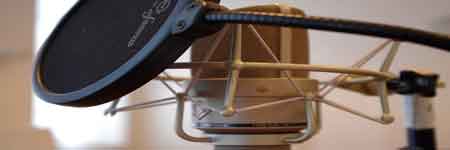When we listen to our favorite artists singing songs on CDs or on our phones, it sounds unbelievable. The way they can belt out the songs without any other sounds creeping in to distract us can sound like magic.
However, a lot more goes into that smooth sounding voice, great music and perfect levels than just an artist standing in front of a microphone and singing. One of the biggest factors in achieving the smooth and interference-free vocals we love to hear is by using a pop filter with your microphone.
If you’re like most people, you might not have the slightest idea of what a pop filter is. However, if you are interested in recording an audio of any kind (from a podcast to music to an interview) you are doing yourself a disservice if you don’t use them.
This article will take a closer look at pop filters and tell you what they are, what they can do, how to choose one for yourself, and much more.
What is a Pop Filter?
So, before we begin talking about the use of pop filters in-depth, let’s first make sure everyone understands what they are. A pop filter is essentially a noise protection filter or shield for microphones. They attach to most microphones and in addition to reducing the “popping” of fast-moving air through the mic during a speech, they also protect your actual microphone from saliva and other bodily fluids. Because they try to remove all those popping noises, some of the sounds are affected. According to MusicCritic, “denser foams tend to obscure the sound somewhat. They can lower the volume level received by the mic requiring more gain. This can lead to feedback issues and distortions.
They are composed of one (or more) layers of a semi-transparent material like metallic mesh or nylon, they often have a circular shape and attach to microphones via a clamp or a mount. They have a bendable and moveable bracket and a flexible neck, so they can move depending on where you position the microphone. They are similar to a microphone windscreen, except for the fact that pop filters are normally used in studios while windscreens are often used outdoors.

Benefits of a Pop Filter
When people say or sing certain words or parts of words, a bit of “popping” normally occurs. This is most common when pronouncing the letter “P” (as in the first P in saying popping will generally have a bit of “pop” to it). The main feature and benefit of a pop filter are to reduce this effect so the “popping” sound isn’t recorded on the audio, as it obviously wouldn’t sound too great.
Basically, the strands of material help to break up the popping sounds and don’t let them actually get to the mic and be recorded. This leaves the audio or singing that you are recording sound as clear as possible.
When people aren’t well versed in recording sound or are amateurs when it comes to microphones, they may often forget to use a pop filter. This would be a mistake as your audio simply won’t sound as crisp, clean or professional as it could.
How to Choose a Pop Filter
So, now that you know what a pop filter is and what the various benefits of using one are, how should you choose which kind of pop filter to get? Thankfully, the internet is a wonderful place and features a lot of information about buying a pop filter. When choosing a pop filter, there are a few different criteria that you should consider before making a purchase.
Price
As with any purchase you make, the cost of the product will come into play. Most will be between $50-$100 or so, but some can be found for noticeably less, which means even if you are just starting out with sound recording, there is no reason not to get a pop filter.
Also, just because one is cheaper and one is more expensive doesn’t always mean one is better. Each has their own different features and a unique design, so the price shouldn’t be the only factor you consider.
Type of Material
The material of your pop filter is a very important thing to consider and will have a large impact on the price and viability. Many of the manufacturers out there today use nylon for their filter, as it is cheaper, but it still gets the job done.
However, if you want the highest quality and best pop filters, you should consider one that is woven with metallic mesh. They often allow more air to pass through, and are highly durable, whereas it doesn’t take much to rip or damage nylon. Cleaning a nylon pop filter is also a more detailed process than a metallic mesh one.
Now, this isn’t saying that nylon pop filters are bad, they are still infinitely better than using nothing at all. Some companies and manufacturers also make dual-layer pop filters that use a layer of each. These can be great, but also potentially lead to dulling of your voice, so choose carefully.
Size
Microphones come in all shapes and sizes and the same can be said about pop filters. Some microphones are small, and won’t need a large pop filter while some are huge, so a small pop filter simply won’t work as well as you need it to.
Some are also flatly designed while others have a curve. They both can be great, but with a flat one, you need to be speaking near the middle of the filter for it to work best, while the curved designs don’t need you to be quite as precise.
The Quality of the Neck
The quality of the entire pop filter relies heavily on the quality of the neck. The “necks” of these pop filters can differ in length, strength, flexibility and more. If your pop filter has a weak neck, it may always droop and if you have one that is too strong, it might be too hard to bend into place.
You want one that is easy to flex and maneuver, but will stay exactly where you want it to without constant adjustments which can make focusing on singing or talking very difficult.
In conclusion, a pop filter will help take your vocal recordings to the next level and will ensure they are as clear as possible. With how affordable and readily available they are, there is no reason not to pick one up for your studio!

